갓 태어난 내 아기에게 줄 수 있는 가장 좋은 선물은 사랑으로 주는 모유이다. The best gift for my newborn infant is the mom breast milk with the love
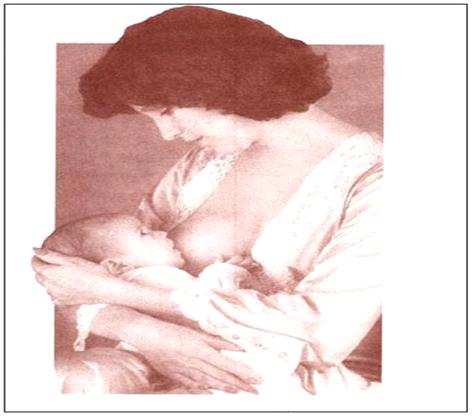
사진 4-1. 모유수유와 사랑
Used with permission from Mead Johnson Nuritionals, USA와 소아가정간호백과-부모도 반의가 되어야 한다.
|
모유는 엄마 아빠의 순수한 사랑이다.
|
- 모유수유로 내 아기를 키우는 것은 엄마의 젖을 먹는 아기에게는 물론이고 젖먹이는 엄마와 아기의 아빠의 정신 육체 건강에 좋다.
- 또 경제적이다.
- 나아가서는 그 나라의 전 국민 육체 건강 증진에도 한없이 좋고 그 나라의 전 국민의 정신건강에도 좋다.
- 사랑하는 내 아기에게 내 젖을 먹여 키우면 아기의 정신 육체 건강에 좋은 점이 많이 있다는 사실을 잘 알고 있다. 그렇지만 모유를 수유하는 방법을 잘 몰라 모유수유를 시작하지 않는 엄마들도 많다.
- 또 인공영양(Artificial formula/Infant formula, 참고로 많은 사람들은 인공영양을 “분유”라고 부른다.)으로 아기를 키우는 것보다 모유수유로 아기를 키우는 것이 아기뿐만 아니라 엄마, 아빠에게도 많은 이점이 있다는 사실을 잘 몰라 아예 모유수유를 시작할 생각도 않는 엄마 아빠들도 있다.
- 모유의 성분과 인공영양의 성분이 거의 비슷하다고 생각도 하고, 또는 똑같다고 생각하는 엄마 아빠들도 많다. 또 인공영양의 성분이 모유의 성분과 같이 아기의 성장 발육 건강에 최고로 좋은 줄로 잘못 알고 있는 엄마 아빠들도 많다.
- 임신 중 모유를 먹여 아기를 키울 것인지 또는 인공영양을 먹여 아기를 키울 것인지 둘 중 한 가지를 선택할 때 엄마 아빠가 내 아기에게 먹이고 싶은 대로 그냥 선택하면 되는 것으로 생각하는 엄마 아빠들도 많이 있다.
- 이런저런 이유로 모유수유로 아기를 키우는 대신 인공영양으로 아기를 키우는 엄마 아빠들이 많이 있게 된다. (참고로 일부 엄마들은 “인공영양”을 “분유”라고 부르기도 한다).
- 알고 보면, 모유수유로 아기를 키우는 것이 인공영양으로 아기를 키우는 것보다 훨씬 더 편리하고 쉽고, 모유를 먹고 자란 아기들은 인공영양을 먹고 자란 아기들보다 훨씬 더 건강하다.
- 모유는 아기들에게 완전한 영양식품이고 영양가가 담뿍 든 자연식품이다. 거기다가 모유는 엄마 아빠의 사랑이다.
- 성장하는 아기들에게 필요로 하는 영양분과 에너지가 모유 속에 다 들어 있다. 모유수유는 젖 먹는 아기에게 모든 병이 생기지 않게 예방하는 효과도 탁월하다. 그래서 모유는 아기의 질병을 예방할 수 있는 예방약이고 백신이고 보약이다.
- 모유수유를 하는 동안 아기는 엄마로부터 받은 눈길 접촉사랑, 신체적 접촉사랑, 집중적 관심적 사랑과 보살핌을 흠뻑 받는다. 모유를 먹는 아기들은 정신적으로 정서적으로 더 만족하고 신체적으로 더 건강하게 자란다. 커서도 건전한 자부심을 더 많이 갖고 산다.
- 모유수유하는 엄마 아빠 역시 엄마의 젖을 자기의 아기에게 직접 먹여 소중한 자녀를 건강하게 키울 수 있다고 생각 할 때 엄마는 자녀 양육에서 더 떳떳하고 자신감과 만족감을 가질 수 있다. 그래서 엄마와 아기에게 사랑 반딩(Love Bonding)이 굳건히 형성된다.
- 안타깝게도 각종 매스컴들은 모유수유로 아기들을 키우는 것이 여러 모로 좋다고 강조하는 데는 인색하다. 또 거기다가 여성들의 유방은 모유수유를 하기 위한 인체의 한 기관인데도 성적인 면이나 육체적 면에 더 관련시키고 있다.
- 여기저기서 받은 잘못된 메시지로 많은 엄마아빠들은 모유수유로 아기들을 키우는 대신 인공영양으로 키우고 있는 실정이다. 불행한 일이다. 그러나 요즘 많은 엄마아빠들이 모유수유로 아기를 키우는 것이 아기들에게도 많은 이점이 있다는 것을 더 확실히 인식해 모유수유 하는 엄마아빠들이 점점 늘어가는 추세인 것은 극히 다행이다.
- 몇 일전 세계 모유수유 장려 행사를 한국 보건복지부, 한국 소아청소년과학회, 한국 산부인과학회 주최로 서울서 열었다. 약300명의 여성들이 참석한 것을 보고 퍽 놀랬다. 모유수유에 정부, 소아청소년과, 산과학회가 동참하는데 놀랬다. 다행스러웠다.
- 자궁 속에서 자라고 있는 아기에게 태어난 아기에게 엄마, 아빠가 엄마의 젖을 먹겠느냐 그렇지 않으면 인공영양을 먹겠느냐 직접 물어보고 무엇을 머길 것인가 결정하는 것이 어떨까?
- 이런 선택권을 산모에게 주고 싶다. 사랑하는 아기에게 소젖을 먹이시곘습니까 그렇지 않으면 엄마의 젖을 먹이시겠습니까.
| 미국 모유수유 현황 |
- 미국 한 연구에 의하면, 분만 후 32%의 산모들은 모유수유를 시작하지도 않는다.
- 약 4%의 산모들은 모유수유를 시작 한 후 1주도 못가서 모유수유를 더 이상 하지 않고,
- 13%의 산모들은 분만 후 1~4주 동안만 모유수유를 한다.
- 그리고 51%는 분만 후 4주 이상 모유수유를 한다고 한다.
- 미국 모유수유 율이 1995년에 59%이었고 2004년에는 74%이었다.
- 생후 6개월까지 미국 모유수유 율은 1995년에 22%이었고 2004년에는 42%이었다.
- 2004년도 미국의 다른 연구에 의하면 주로 모유수유만 한 모유수유 율은 분만 후 7일까지 51%이었고 분만 후 6개월까지 모유수유 율은 불과 14%이었다. (소스와 참고서; Arch Pediatr Adolesc Med. 2008.)
| 모유와 모유수유의 좋은 점 |
Advantages of breast milk and breastfeeding
모유와 모유수유의 좋은 점에 관해서 이미 설명 했다. 모유수유로 아기를 양육할 때 모유수유의 좋은 점을 구체적으로 더 알아보자.
- 모유의 온도는 언제든지 어디서든지 아기에게 바로 먹을 수 있게 적절하다.
- 인공영양으로 아기를 양육할 때는 인공영양을 먹이기 전 우유병, 우유병 꼭지, 우유병 마게 등을 깨끗이 씻어야 한다.
- 때로는 그 우유병, 우유병 꼭지 등을 끓는 물로 살균 처리해야 한다. 인공영양의 온도를 먹기 좋게 조절해야 한다. 모유수유를 할 때는 우유병 등을 씻고 소독할 필요가 없다.
- 인공영양을 먹이기 위해 준비하는 바로 전까지 박테리아나 바이러스 등 병원체가 인공영양에 오염될 수 있다.
- 모유를 수유 하는 중, 수유모 체외 박테리아, 바이러스, 그 외 다른 종류의 병원체가 빨아 먹는 모유 속으로 쉽게 오염되지 않다. ( 모유수유 금기 참조)
- 모유를 먹고 자라는 아기들은 인공영양을 먹고 자라는 아기들에 비해 박테리아, 바이러스, 그 외 다른 병원체의 감염으로 감염병에 훨씬 덜 걸릴 수 있다.
- 또 감염병, 소화 장애, 알레르기 위장염, 그 외 다른 여러 종류의 병에 덜 걸린다.
- 양육비, 의료비가 절약되고 병원에 갈 일도 적게 생기고 병원 입원치료를 받을 가능성도 적다.
- 모유를 먹고 자라는 아기들은 바이러스성 위장염이나, 호흡기계 질환, 중이염, 설사, 박테리아 뇌막염, 요로 감염, 그 외 다른 종류의 병원체 감염에 덜 걸린다.
- 모유는 인공영양보다 소화가 더 잘 된다.
- 모유는 각종 질환에 덜 걸리게 해서 아기를 보호한다.
- 엄마의 젖을 먹고 자라는 아기들은 인공영양을 먹고 자라는 아기들에 비해 알레르기성 비염, 알레르기성 소화기 질환, 기관지 천식, 아토피 피부염 등 알레르기 질환에 훨씬 덜 걸린다.
- 모유를 먹는 아기들에게는 인공영양을 먹는 아기들에 비해서 영아산통, 변비가 덜 생긴다.
- 엄마의 젖을 먹고 자라는 아기들에게도 알레르기 질환이 생길 수 있지만 우유 단백이나 콩 단백의 성분이 든 인공영양을 먹고 자라는 아기들에게는 알레르기 질환이 훨씬 더 생긴다.
- 박테리아, 바이러스, 그 외 다른 종류의 병원체의 침입을 받았을 때 그 병원체를 죽일 수 있는 IgA 등 면역글로빈, 백혈구, 거대세포, 보체(Complements), 락토페린(Lactoferrin), 라이소자임(Lysozyme) 등 항 병원체 인자와 그 외 다른 생화학 물질이 모유 속에 들어 있으나 인공영양 속에는 들어 있지 않다. 그래서 젖 먹는 아기들은 중이염, 위장염, 패혈증, 폐렴, 요로 감염 등 여러 종류의 감염병에 덜 걸린다.
- 최근 인공영양 속에 뇌와 눈의 기능을 증진시키는데 필수적으로 필요한 DHA와 ARA 성분을 첨가 조제 하지만 모유 속에는 자연 DHA와 ARA 성분이 충분히 들어 있다.
- 그 외 신체의 성장 발육을 촉진시킬 수 있는 생화학적 물질도 모유 속에 들어 있다.
- 암을 예방할 수 있는 생화학적 물질이 모유 속에 들어 있다.
- 성장 발육을 촉진시키는 호르몬이 들어 있다.
- 인공영양을 먹고 자란 아이들의 지능 지수는 모유를 먹고 자란 아이들의 지능 지수보다 더 낮고 학습장애가 더 잘 생길 수 있다.
- 임신 중 아무리 잘 태교해도 모유 대신 인공영양을 먹고 자라는 아이들의 IQ가 더 낮다.
- 인공영양을 먹고 자란 아이들은 과식하는 경향이 더 많고 더 쉽게 비만해진다. 소아 비만이 생기고 결국 성인 비만으로 이어지기 더 쉽다.
- 1형 당뇨병이나 2형 당뇨병의 발생률이 모유를 먹고 자란 아이들에게 덜 발생한다.
- 백혈병, 림프종, 호지킨병, 고 콜레스테롤 혈증, 고지질 혈증과 고지질 단백 혈증 등 신진대사 질환 발생률이 모유를 먹고 자란 아이들에게 덜 발생한다.
- 인공영양을 먹고 자란 아이들에게 모유를 먹고 자란 아이들에 비해 충치, 부정교합 등 치아장애 발생률이 더 높고 얼굴 근육 발달 장애 발생률이 더 높다. .
- 비피도박테륨 랰티스(Bifidobacterium lactis) 박테리는 모유를 먹는 아기들의 위장관 속 상존 균 군집의 80~90%를 차지한다.
- 젖 먹는 아기들의 위장관 속 비피도박테륨 박테리아 군집은 위장관 속에 병원성 박테리아가 자라지 못하게 하는 역할을 하고 장관 점막층에서 lgA 항체 생성 증진을 촉진된다.
- 그래서 모유를 먹고 자라는 아기들은 병원성 박테리아 감염으로 박테리아 감염성 위장염에 덜 걸린다.
- 그리고 비피도박테륨 박테리아는 모유를 먹는 아기들의 성장 발육을 촉진시킨다. 이런 이유로 요즘 비피도박테륨(Bifidobacterium lactis)을 인공영양에 첨가해 조제하기도 한다.
- 생후 0~6개월까지 정상적으로 성장 발육하는 데 필요로 하는 단백질, 탄수화물, 지방, 비타민, 수분, 미네랄 등이 균형 잡힌 음식물을 충분히 섭취한 건강한 수유모의 모유 속에는 충분히 들어 있다.
- 인공영양을 먹일 때 엄마가 품에 아기를 폭신 않고 사랑하면서 인공영양을 잘 먹이면 아기는 잘 자랄 수 있지만 엄마가 따뜻한 유방 젖꼭지를 아기의 입안에 물리고 유방을 아기의 살갗에 직접 대고 젖을 먹을 때 느낄 수 있는 신체 접촉 사랑과 비교할 수 없다.
- 엄마가 아기를 품에 안고 젖을 먹일 때 아기는 엄마의 눈길 접촉사랑, 신체적 접촉사랑, 그리고 집중적 관심적 사랑과 보살핌을 더 많이 받고 있다고 느낀다.
- 엄마의 젖을 아기에게 먹이는 동안 엄마의 신체 내 모성 호르몬(엄마 호르몬)이 분비된다. 이 호르몬은 엄마의 젖을 먹는 아기가 모정을 듬뿍 느낄 수 있게 촉진 시키고 엄마와 아기의 모자간 사랑 반딩을 더 굳건히 형성되게 하며 아기가 정신적으로 정서적으로 더 안정감을 갖게 하는 역할을 한다. 그 호르몬은 옥시토신(Oxytocin)이다.
- 엄마는 자신의 젖을 아기에게 직접 먹여 내 자식을 더 건강하게 더 똑똑하게 잘 키울 수 있다는 자신감을 더 많이 가질 수 있다.
- 수유하는 엄마 아빠와 아기 모두는 정신적으로 육체적으로 안정감을 더 갖게 된다. 엄마 아빠와 아기 사이에 부모 자식 간 사랑 반딩(Bonding)이 더욱 굳게 형성된다.
- 모유수유하는 동안 임신 분만으로 생긴 자궁의 변화, 육체적 정신적 변화와 피로 등이 정상적으로 더 빨리 회복될 수 있다.
- 모유수유를 하는 동안 자연적으로 피임될 수 있다.
- 모유수유는 다이어트 역할을 한다.
- 임신 중 증가됐던 산모의 체중이 임신 전 체중으로 더 빨리 더 쉽게 돌아간다.
- 끝으로 모유는 아기에게 가장 좋고 이상적이고 가장 완전한 자연 음식물이다.
- 모유는 엄마 아빠가 자녀에게 주는 가장 좋은 사랑이다. 모유수유로 아기를 키우면 수유모, 아빠, 젖 먹는 아기는 물론, 그 가정, 그 사회, 그 국가 모두의 정신, 정서, 육체의 건강증진에 좋다.
- 모유수유는 경제적이다.
- 젖 먹는 아이들의 일생의 삶의 가장 좋은 보약이다.
- 최근, 인공영양을 ‘모유와 거의 비슷하게 만들 수 있다는 광고도 있다. 그러나 과학이 아무리 발달해도 인공영양을 모유와 똑같게 만드는 건 불가능하다.
- 인공영양을 조제, 판매 구입 보관하는 과정에 문제가 생길 수 있다. 인공영양을 먹일 준비를 하는 동안 인공영양에 박테리아가 오염될 수 있다. 권장한 양보다 물의 양을 더 적게 더 많게 넣을 수 있다. 부적절한 인공영양 성분으로 만들어 먹일 수 있다.
- 물론 모유수유를 할 때 수유모 체 내외에 있는 박테리아 등 병원체에 오염될 가능성은 있지만 특별한 경우를 제외하고, 모유수유를 하는 중 엄마로부터 병원체에 감염될 가능성은 아주 낮다.
- 인공영양을 먹이는 경우와 모유수유를 할 때 엄마와 아기가 서로 주고받는 특별한 느낌은 아주 다르다. 엄마의 따뜻한 품에 안기어 따뜻한 젖꼭지를 빨 때 느낌과 우유병 꼭지를 빨 때 느낌은 천지 차이일 것이다..
- 불행하게도 오늘 날 많은 산모들이 분만 후 분만 회복을 하지 못하고, 산후 조리도 제대로 하지 못한 채 승용차를 몰고 병원 산실에서 퇴원해 집으로 간다. 아기에게 인공영양을 먹이는 산모들은 인공영양과 우유병 꼭지 등을 구입하기 위해 쇼핑몰 여기저기로 간다.
- 요즘 산모들은 경제적 문제, 가정적 문제 등 여러 가지 문제로, 분만 후 육체적으로 정신적으로 충분히 쉬지 못하고 전업 직장으로 뒤돌아 간다. 사정이 이렇다 보니 모유수유의 장점을 잘 알면서도 부득이 인공영양으로 사랑하는 아기들을 양육하는 실정이 많다.
- 성장하는 어린 아이들뿐만 아니라 부모들 특히 젖 먹이는 엄마들 그리고 세계 각 국가들이 요즘 안고 있는 불행한 자녀양육 실태이다.
- 모유수유로 아기를 양육하는 것이 가장 이상적이라는 건 의심할 여지가 없다. 모유가 최고의 자연 영양식이라는 것도 더 이상 논할 필요가 없다.
- 최근 미 소아청소년과학회, 미 연방 정부, 각종 모유수유 장려 단체는 모유수유 증진 정책에 동참하고 있다.
- 특히 의과 대학 및 모자보건부 등 소아 건강 증진에 관련되어 있는 비영리 단체나 소아건강 문제를 다루는 소아청소년과 전문의들 및 간호사들은 모유수유 증진 정책에 적극적으로 참여해야 한다고 주장한다.
- 분만하기 전 장차 태어날 아기의 단골 소아청소년과 의사가 될 의사는 예비 엄마들에게 모유수유의 이점에 관해 설명하고 아기가 태어나면 인공영양을 먹이겠느냐 또는 모유를 먹이겠느냐 선택권을 주지 말고 갓 태어난 모든 아기에게 모유를 먹이도록 모두가 장려하고 있다.
- 끝으로, 갓 태어난 내 아기에게 엄마아빠가 줄 수 있는 가장 좋은 선물이 무엇이냐고 나에게 묻는다면 나는 두말할 것 없이 ‘모유수유’라고 답할 것이다.
- 물론 모유와 사랑을 함께!
|
다음은“모유수유, 유방 구조, 모유수유 호르몬 프로랙틴”에 관한 백문 백답입니다. |
Q.&A. 모유수유, 유방 구조, 모유수유 호르몬 프로랙틴에 관한 백문 백답
Q. 유방이란?
A.젖샘(Mammry gland/breast), 즉 유방은 모유를 생성하는 외분선이다. 여성 생식기계의 일부이다. 유방은 앞가슴의 피하조직, 2~6번째 늑골의 사이, 대흉근육, 흉골과 겨드랑이 사이에 위치하고 있다. 유방의 중앙 부위에 젖꼭지가 있다. 젖꼭지를 유두라고 한다. 젖꼭지는 양쪽 유방에 하나씩 있다. 그 유두의 뿌리를 둘러싼 피부부분을 유두륜, 유륜, 젖꼭지판, 또한 젖무리라고 한다. 유륜에는 몽고메리선이 있다. 여기서 피지가 분비된다. (그림 22-41 참조)
Q. 유방의 내부의 구조는?
A. 한 개의 유방 속에는 15~20개 젖샘엽이 있다. 각 젖샘엽에는 유선(포상샘/ 포상선/젖샘)이 많이 있다.
그 포상샘은 포상샘 분비관에 연결되어 있다. 그 포상샘 분비관은 팽대부(유동)로 연결되어 있다. 그 팽대부(유동)는 다시 유관(젖샘관)으로 연결되어 있다. 그 유관은 유두의 젖 구멍으로 연결되어 있다. 유두의 젖 구멍에서 젖이 나온다. (그림 유방 참조)
Q. 유방에서 젖이 만들어지는 경로는?
A. 아기가 젖을 먹을 때 꼭지를 빨 으면서 유륜을 자극하면→ 신경 임펄스가 뇌 시상하부로 전달되고→ 시상하부에서 뇌하수체 후엽으로 신호를 보내어 옥시토신(피토신)분비되고→ 옥시토신은 포상샘을 둘러싸고 있는 근상피세포를 자극하고→ 포상샘(유선)에서 젖(모유)이 분출되고→ 포상샘 분비관→ 팽대부→ 유관(젖샘 관)→ 유두→ 유두 젖구멍을 통과해 젖이 분비된다. 결합조직과 지방조직이 각 젖샘 엽 사이에 있다.
Q. 유방은 어떻게 발육되나?
A.사춘기가 되기 전 까지 남,여아의 유방의 구조는 거의 같다.
사춘기가 시작되면 여성의 난소의 황체에서 분비되는 에스트로겐과 프로게스테론이라는 여성호르
몬에 의해서 유선(젖샘)과 포상샘 분비관(젖분비관) 등이 발육되고 커진다. 그리고 지방조직이 유방 속에 축적된다. 그래서 사춘기 여아들의 유방이 예쁘게 커진다.

사진 4-2.모유수유로 아기를 양육하면 아기에게 이롭고 좋은 점이 참 많다. 모유수유를 하는 동안 엄마의 살갗과 아기의 살갗이 서로 접촉될 때 생기는 신체적 접촉사랑, 거기다가 엄마가 주는 집중적 관심적 사랑 및 보살핌을 받을 수 있는 것은 또한 아기에게도 이롭고 엄마에게도 이롭다. 이런 사실이 있다는 것을 알게 모르게 그냥 지나가고 있다. 젖 먹는 아기는 엄마의 눈길접촉 사랑을 받을 수 있고 엄마 역시 아기로부터 눈길접촉 사랑을 받을 수 있다. 이런 사랑은 모유수유를 하는 중 젖을 먹는 아기와 수유모에게만 생긴다. Copyright ⓒ 2013 John Sangwon Lee, MD., FAAP
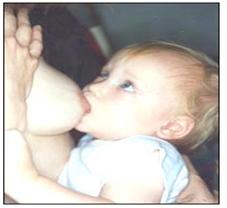
사진 4-3.젖 먹는 아기의 눈길을 보라! 엄마의 눈길과 아기의 눈길 접촉사랑을! 바로 이런 눈길 접촉사랑을 통해 모자간의 사랑의 반딩(Bonding)이 굳건히 형성된다. 이런 사랑의 반딩(Bonding)은 모유수유를 할 때 더 굳건히 형성된다. Copyright ⓒ 2011 John Sangwon Lee, MD., FAAP
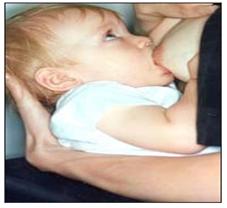
사진 4-4.젖 먹는 아기의 눈길을 보라! 엄마의 눈길과 아기의 눈길 접촉사랑을! 바로 이런 눈길 접촉사랑을 통해 모자간의 사랑의 반딩(Bonding)이 더 굳건히 형성된다. Copyright ⓒ 2011 John Sangwon Lee, MD., FAAP
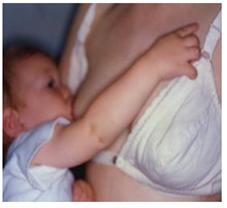
사진 4-5. 젖 먹는 아기의 신체적 접촉 사랑을 보라! 엄마의 신체와 아기 간 신체적 접촉사랑을! 바로 이런 신체적 접촉사랑을 통해 모자간의 사랑 반딩(Bonding)이 더 굳건히 형성된다.
Copyright ⓒ 2011 John Sangwon Lee, MD., FAAP
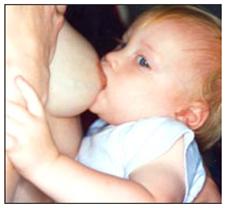
사진 4-6. 젖 먹는 아기의 신체적 접촉을 보라! 엄마의 신체와 아기의 신체적 접촉사랑을! 바로 이런 신체적 접촉사랑을 통해 모아간의 사랑 반딩(Bonding)이 더 굳건히 형성된다. Copyright ⓒ 2011 John Sangwon Lee, MD ., FAAP
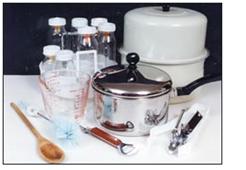
사진 4-7.인공영양을 먹이기 위해 필요로 하는 것들이 더 많이 있다. Copyright ⓒ 2011 John Sangwon Lee, MD., FAAP
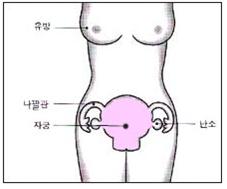
그림 4-1. 분만 후 모유수유를 하지 않는 산모의 자궁은 피토신 호르몬의 영향을 적게 받아 서서히 수축되고 서서히 회복된다. Copyright ⓒ 2011 John Sangwon Lee, MD., FAAP
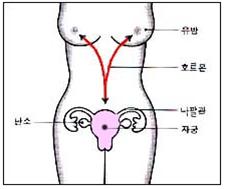
그림 4-2. 분만 후 모유수유를 하는 산모의 자궁은 피토신 호르몬의 영향을 받아 더 빨리 수축되고 회복된다. Copyright ⓒ 2011 John Sangwon Lee, MD., FAAP
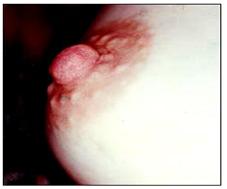
사진 4-8. 유두륜(유륜, 젖꼭지판)에 두드러지게 나온 여러 개의 작은 결절들이 있다. 그 결절들을 몽고메리 결절이라고 한다. 몽고메리 결절 속에 몽고메리 분비선이 있다. 거기에서 크림과 같은 윤활성 피지가 분비된다. Copyright ⓒ 2011 John Sangwon Lee, MD., FAAP

사진 4-9. 모유는 데우지 않아도 언제든지 먹을 수 있게 온도가 적절하다. 사진에서 유륜에 나있는 몽고메리 돌기 끝부분이 선명하게 보인다. Copyright ⓒ 2011 John Sangwon Lee, MD., FAAP
Q. 임신하면 유방에도 변화가 온다고 하던데?
A. 임신이 되면 임신부의 신체에 많은 변화가 현저하게 생긴다.
그 중 더 특별하고 현저하게 생기는 신체적 변화는 자궁과 유방에 오는 변화이다.
장차 태어날 아기가 젖을 먹고 자라건 인공영양을 먹고 자라건 임신부는 장차 태어날 내 소중한 아기가 젖을 충분히 먹고 건강하게 자랄 수 있게 유방 속 포상샘과 젖 분비 세포 및 젖 분비선계가 발달된다.
유방 속에 유선관(포상샘 분비관계), 팽대부, 유관(젖샘 관) 등이 왕성하게 발달하고 젖꼭지가 커지고 유방 내 지방조직이 축적되고 유방 전체가 커진다.
유륜에 몽고메리선이 발달되어 거기서 피지가 생성되어 모유를 수유하기에 더 편리하게 유방 모든 것이 착착 진행된다.
유방이 탄탄하게 커지는 처음 얼마동안에는 좀 얼 얼거리고 아플 수 있다. 특히 유두가 어디에 닿으면 상당히 아플 수 있다.
한 개의 유방 안에는 15~20개의 유방 엽이 있다.
한 개의 유방 엽은 여러 개의 작은 유방 소엽들로 구성되어 있고,
유방 소엽들은 다시 더 세분된다.
그 유방소엽 속에 젖을 만드는 젖 세포들이 있다.
젖 세포들이 모여 젖선(포상샘)이 된다.
이 젖샘을 포상샘, 또는 유선이라고도 한다.
젖 선(腺)에서 만들어진 젖이 흘러가는 관을 포상샘 분비관이라 한다. 크고 작은 포상샘 분비관을 통틀어 포상샘 분비관계라고 한다. (그림 유방 참조)
아기가 젖꼭지를 빨아 먹기 전에 젖 선에서 분비된 젖이 괴여 있는 유방 속 동을 유동 또는 팽대부라고 한다. 임신이 되자마자 이런 유방 내부 젖분비선계의 조직이 점점 더 커지고 발달된다. 그리고 분만하기 바로 전까지 유방의 기능이 알게 모르게 더 활성화된다.
임신 중 태반에서 분비되는 항 프로택틴 호르몬(Antiprolactin hormone)의 작용으로 프로랙틴(Prolactin)이 포상샘의 젖 분비세포를 자극해서 젖이 분비되지 못하게 작용하고 있다가 아기가 태어난 후 태반이 자궁 속에서 배출 되자마자 프로랙틴이 젖분비 세포들을 자극하기 시작하고 젖분비 세포들이 젖을 만들기 시작한다. 그러나 프로랙틴이 분만 후 왕성하게 작용하기 시작하는 데는 1~2일의 시간이 필요하다.
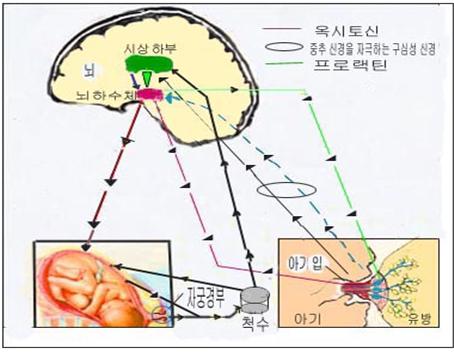
그림 4-3. 모유 분비, 자궁경관의 확장, 모유분비 자극 호르몬(프로랙틴), 유방의 유동 내로 모유를 분출시키는 옥시토신 호르몬, 젖꼭지를 빨 때 생길 수 있는 프로랙틴 호르몬 분비, 프로랙틴 분비 억제 호르몬. Copyright ⓒ 2011 John Sangwon Lee, MD ., FAAP
Q. 유방은 어떻게 젖을 만들어내나?
A. 아기가 젖꼭지를 빨 때는 젖꼭지와 유륜 등에 있는 말초 신경이 자극 받는다. 이 때 아기가 젖을 빤다는 신호가 신경 임펄스(neural impulse)를 통해 수유모의 뇌에 있는 시상하부로 전달된다.
시상하부에서 신경 임펄스가 수유모의 뇌하수체의 후엽에 전달된다.
수유모의 뇌하수체 후엽에서 옥시토신(Oxytocin/pitocin)호르몬이 분비되고 그 옥시토신 호르몬은
포상샘 세포를 싸고 있는 근상피세포를 자극해서 모유가 포상샘 분비관으로 분비되게 한다.
유방 내 젖 세포에서 유방 젖 분비관계 속 유동 속으로 이미 분비되어 있는 모유가 포상샘 분비관계(유관) 등을 통해 젖꼭지 쪽으로 흘러나오도록 포상샘 분비관계를 자극한다.
그와 동시에 젖꼭지를 빨 때 생긴 신경 임펄스가 수유모의 시상하부로 전달되고 그 다음 뇌하수체 전엽에 전달된다.
프로랙틴(Prolactin)호르몬이 수유모의 뇌하수체의 전엽에서 분비된다. 그 프로랙틴 호르몬은 유방의 젖 분비세포(젖 세포)를 자극해 젖 분비를 촉진시킨다.
그와 동시에 유방 내 혈액 순환이 더 왕성해지고 유방 내 지방조직이 더 발달되고 지방이 유방 안에 더 축적된다.
유방의 피하 조직에 있는 정맥 혈관들이 유방 피부층을 통해 육안으로 쉽게 볼 수 있을 정도로 커진다.
임신 중 유방이 커지기 때문에 유방의 피부층에 신장반(임신선)이 생길 수 있다.
분만 후 아기가 젖을 빨 때 신경 임펄스가 시상하부로 전달되고 그 다음 뇌하수체 후엽으로 전달된다.
뇌하수체 후엽에서 옥시토신이 분비되어 모유가 분출된다. 임신 중에는 태반에서 분비되는 프로랙틴 분비 억제 호르몬에 의해서 아기가 태어나기 전에는 프로랙틴이 유방을 자극 할 수 없다.
모든 이런 생리를 배우다 보면 우리 몸의 생리는 컴퓨터 칩의 기능과 비슷하게 만들어 졌다고 생각 한다.
Q. 임신 중 젖꼭지와 유두륜에 크림 같은 것이 생기면 씻어내야 하나?
A. 임신 중 유두는 보통 때 크기의 배로 커지고 유두의 끝 부분에 15~20개 정도 젖나오는 구멍들이 있다.
유두의 뿌리의 주위에 있는 유륜(유두륜)의 크기도 배로 커진다. 유두와 유륜의 색은 짙은 흑갈색이거나 또는 진분홍색으로 변한다.
아마도 젖 먹는 아기가 육안으로 쉽게 보고 쉽게 찾을 수 있게 유두와 유륜의 색이 이렇게 변화된 것 같다.
유륜에는 몽고메리 결절이 여러 개 정상적으로 나있다. 그 몽고메리 결절 속에 몽고메리 선이 있고 거기에서 크림과 같은 윤활 피지가 분비돼 유륜과 유두를 부드럽게 해서 수유 중 유두와 유륜이 갈라지거나 터지지 않게 하는 역할을 한다.
즉 기계가 잘 돌아가도록 기계에 기름을 치는 것과 거의 같은 이치이다.
임신 기간 동안과 분만 후 모유수유하는 동안 윤활 피지는 유두와 유륜을 보호해 주는 역할을 한다.
몽고메리 선에서 분비된 크림 같은 윤활 피지를 비누로 씻어내서는 안 된다. 그리고 유두나 유륜에 국소 도포용 크림을 특별히 바를 필요도 없다.
Q. 유방의 크기가 작은 편인데 아기한테 충분한 양의 모유가 나올까?
A.임신부에 따라 유방의 크기와 모양에 차이가 많다.
유방의 크기가 상당히 크던 작던 늘어졌던 탄탄하던 모든 산모의 유방은 한 아기 또는 두 아기가 동시 먹고 자랄 수 있도록 충분한 양의 모유를 분비할 수 있다.
소아청소년과 의사가 바라는 유방의 궁극적인 목적은 안정하고 편안한 느낌을 아기에게 주고 아기가 먹고 건강하게 자랄 수 있게 따뜻한 모유를 충분히 분비하는 것이다.
임신 5~6 개월경부터 유두에 있는 여러 개의 젖 구멍에서 맑은 젖이 몇 방울 정도 나올 수 있다. 이 젖은 초유의 일종이다. 이 젖은 마유라고도 한다.
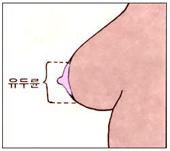
그림 4-4. 유방과 유두륜
Copyright ⓒ 2011 John Sangwon Lee, MD ., FAAP
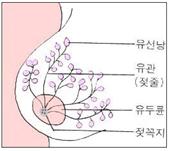
그림 4-5. 모유수유와 유방
Copyright ⓒ 2011 John Sangwon Lee, MD., FAAP
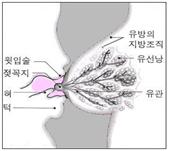
그림 4-6. 모유수유를 할 때 아기의 입과 유방과 젖꼭지의 상관관계도
Copyright ⓒ 2011 John Sangwon Lee, MD., FAAP
| 임신하지 않은 성인 여성의 유방, 임신한 성인 여성의 유방, 모유수유하는 성인 여성의 유방의 그림 |

그림 4-7. 임신하지 않은 여성의 유방(a), 임신한 여성의 유방(b), 수유하는 여성의 유방(c)을 비교.
-
임신하지 않은 여성의 유방은 가장 작다. 포상샘, 포상샘 분비관, 유동, 젖샘관(유관)이 수유모의 유방에 있는 것들에 비해 훨씬 더 작기 때문이다.
-
임신한 여성의 유방은 모유분비선계가 더 잘 발달되어 있고 더 커졌다.
-
수유하는 여성의 유방은 가장 크고 지방조직이 눈에 띄게 많다. 포상선(포상샘)도 크게 잘 발달됐다. 포상샘 분비관이 더 크고 유동(팽대부)도 더 크고 젖샘관(유관)도 더 크다. 젖꼭지도 유륜도 크다. 소스: Used with permission from Ross Laboratories, Columbus, Ohio 43216, Division of Laboratories, USA와 소아가정간호백과
표 성숙 모유, 이행성(변이) 모유, 초유, 우유의 성분 비교표 Composition of mature breast milk, transitional breast milk, colostrum and cow’s milk
|
모유, 초유 우유
성분 |
모유 | 우유 | ||||||
| 분만 후 15일부터 15개월 동안 분비되는
성숙 모유 |
분만 후 6일에서 10일 동안 분비되는
이행성 모유 |
분만 후 첫 5일 동안에 분비되는
초유 |
||||||
| 평균 | 시험범위 | 평균 | 시험범위 | 평균 | 시험범위 | 평균 | 시험범위 | |
| 칼로리 (kcal/liter) | ||||||||
| 747 | 446-1192 | 735 | 678-830 | 671 | 588-730 | 701 | 587-876 | |
| ml/liter | 3.127 | 1.867-4.989 | 3.076 | 2.838-3.474 | 2.808 | 2.461-3.055 | 2.934 | 2.457-3.666 |
| 비중 | 1.031 | 1.026-1.037 | 1.035 | 1.034-1.036 | 1.034 | – | 1.031 | 1.028-1.033 |
| 수소 이온 농도 지수 | 7.01 | 6.4-7.6 | – | – | – | – | 6.6 | – |
| 고형질, 총 (g/liter) | 129 | 103-175 | 133 | 105-156 | 128 | 100-167 | 124 | 119-142 |
| 회분, 총 (g/liter) | 2.02 | 1.6-2.66 | 2.67 | 2.31-3.38 | 3.08 | 2.47-3.50 | 7.15 | 6.81-7.71 |
| 미네랄 (g/liter) | – | – | – | – | – | – | – | – |
| 양성전자원소 (㎎/liter) | 41 | – | 55 | – | 68 | – | 149 | 0.390-0.139 |
| 소듐 (g/liter) | 0.172 | 0.064-0.436 | 0.294 | 0.192-0.539 | 0.501 | 0.265-1.37 | 0.768 | 0.392-0.139 |
| 0.189 | 0.080-0.350 | 0.536 | 0.170-1.21 | 0.956 | 0.330-2.24 | – | – | |
| 포타슘 (g/liter) | 0.512 | 0.373-0.635 | 0.636 | 0.528-0.769 | 0.745 | 0.658-0.870 | 1.43 | 0.38-2.87 |
| 0.553 | 0.425-0.735 | 0.692 | 0.450-0.910 | 0.581 | 0.220-0.790 | – | – | |
| 칼슘 (g/liter) | 0.344 | 0.173-0.609 | 0.464 | 0.23-0.628 | 0.481 | 0.242-0.656 | 1.37 | 0.56-3.81 |
| 0.271 | 0.207-0.372 | 0.320 | 0.166-0.420 | 0.261 | 0.180-0.364 | – | – | |
| 마그네슘 (g/liter) | 0.035 | 0.018-0.057 | 0.035 | 0.026-0.054 | 0.042 | 0.031-0.082 | 0.13 | 0.07-0.22 |
| 음성전자원소 (㎎/liter) | 28 | – | 37 | – | 40 | – | 108 | – |
| 인 (g/liter) | 0.141 | 0.068-0.268 | 0.198 | 0.097-0.317 | 0.157 | 0.085-0.251 | 0.91 | 0.56-1.12 |
| 황 (g/liter) | 0.14 | 0.05-0.30 | 0.20 | 0.15-0.23 | 0.23 | 0.20-0.26 | 0.30 | 0.24-0.36 |
| 염소 (g/liter) | 0.375 | 0.088-0.734 | 0.457 | 0.305-0.721 | 0.586 | 0.435-1.01 | 1.08 | 0.93-1.41 |
| 과양성 원소 (㎎/liter) | 13 | – | 18 | – | 28 | – | 41 | – |
| 극소물질 | ||||||||
| 코발트 (㎎/liter) | 극소 | – | – | – | – | – | 0.6 | – |
| 철 (㎎/liter) | 0.50 | 0.20-0.80 | 0.59 | 0.29-1.45 | 1.0 | – | 0.45 | 0.25-0.75 |
| 동 (㎎/liter) | 0.51 | – | 1.04 | – | 1.34 | – | 0.102 | – |
| 망간 (㎎/liter) | 극소 | – | 극소 | – | 극소 | – | 0.02 | 0.005-0.0067 |
| 아연 (㎎/liter) | 1.18 | 0.17-3.02 | 3.82 | 0.39-5.88 | 5.59 | 0.72-9.81 | 3.9 | 1.7-6.6 |
| 불소 (㎎/liter) | 0.107 | 0.0-0.24 | – | – | 0.131 | 0.0-0.35 | – | 0.10-0.28 |
| 옥소 (㎎/liter) | 0.061 | 0.044-0.093 | – | – | – | 0.045-0.450 | 0.116 | 0.036-1.05 |
| 셀레늄 (㎎/liter) | 0.021 | – | – | – | – | – | 0.04 | 0.005-0.067 |
| 단백질 (g/liter) | ||||||||
| 총 | 10.6 | 7.3-20 | 15.9 | 12.7-18.9 | 22.9 | 14.6-68.0 | 32.46 | 28.16-36.76 |
소스와 참조 문헌: Nelson textbook, 15 Edition p.121,
Pediatric nutrition handbook, American Academy of pediatric, p.354
그 외
|
모유, 초유 우유
성분 |
모유 | 우유 | |||||||
| 분만 후 15일부터 15개월 동안 분비되는 성숙 모유 | 분만 후 6일에서 10일 동안 분비되는 이행성 모유 | 분만 후 첫 5일 동안에 분비되는 초유 | |||||||
| 성분 | 평균 | 시험범위 | 평균 | 시험범위 | 평균 | 시험범위 | 평균 | 시험범위 | |
| 탄수화물 | |||||||||
| 유당 | |||||||||
| 직접추정 (g/liter) | 71 | 49-95 | 64 | 61-67 | 57 | 11-79 | 47 | 49-50 | |
| 차이 | 68 | 50-92 | 64 | 60-68 | – | – | – | – | |
| 과당 (g/liter) | 1.3 | – | – | – | – | – | – | – | |
| 글루코사민 (g/liter) | – | 0.7-0.8 | – | – | – | 1.4-4.3 | 0 | – | |
| 갈락토사민 (g/liter) | – | 0.0-0.4 | – | – | – | 0.04-0.7 | 0 | – | |
| 이노시톨 (g/liter) | 0.45 | 0.39-0.56 |
– |
– | – | – | 0.08 | 0.06-0.12 | |
| 구연산 (g/liter) | – | 0.35-1.25 | – | – | – | – | 2.54 | 2.15-2.9 | |
| 지방, 총 (g/liter) | 45.4 | 13.4-82.9 | 35.2 | 27.3-51.8 | 29.5 | 24.7-31.8 | 38.0 | 34.0-61.0 | |
| 콜레스테롤 (㎎/liter) | 139 | 88-202 | 241 | 126-320 | 280 | 180-345 | 110 | 70-170 | |
| 자유콜레스테롤 (총양의 %) | 76.1 | – | 76.5 | – | 79.5 | – | – | 90-95 | |
| 인 지질 (㎎/liter) | 10.5 | 7-14 | 15.5 | 11-20 | 12 | 6-17 | – | 53-70 | |
| 비타민 | |||||||||
| 비타민A (㎎/liter) | 0.61 | 0.15-2.26 | 0.88 | 0.58-1.83 | 1.61 | 0.75-3.05 | 0.27 | 0.17-0.38 | |
| 캐토틴 (㎎/liter) | 0.25 | 0.02-0.77 | 0.38 | 0.23-0.63 | 1.37 | 0.41-3.85 | 0.37 | 0.12-0.79 | |
| 비타민 D (IU/liter) | – | 4-100 | – | – | – | – | – | 5.40 | |
| 토코페롤 (㎎/liter) | 2.4 | 1.0-4.8 | 8.9 | 4.0-18.5 | 14.8 | 2.8-30.0 | 0.6 | 0.2-1.0 | |
| 지아민 (㎎/liter) | 0.142 | 0.081-0.227 | 0.059 | 0.023-0.105 | 0.019 | 0.009-0.034 | 0.43 | 0.28-0.900 | |
| 리보플라빈 (㎎/liter) | 0.373 | 0.198-0.790 | 0.369 | 0.275-0.490 | 0.302 | 0.120-0.453 | 1.56 | 1.16-2.02 | |
| 비타민 B6 (㎎/liter) | 0.18 | 0.10-0.22 | – | – | – | – | 0.51 | 0.40-0.63 | |
| 니코틴 산 (㎎/liter) | 1.83 | 0.66-3.30 | 1.75 | 0.60-3.60 | 0.75 | 0.50-14.5 | 0.74 | 0.50-0.86 | |
| 비타민 B₁₂ (㎍/liter) | – | 극소량 | 0.36 | 0.03-0.70 | 0.45 | 0.10-1.5 | 6.6 | 3.2-12.4 | |
| 엽산 (IU/liter) | |||||||||
| (a) | 1.4 | 0.9-1.8 | 0.2 | 0.15-0.25 | 0.5 | 0.10-1.5 | 1.3 | 0.2-4.0 | |
| (b) | 24.0 | 7.4-61.0 | – | – | – | – | 37.7 | 16.8-63.2 | |
| (c) | 7.3 | 2.3-17.6 | – | – | – | – | 12.6 | 2.8-43.6 | |
| 바이오틴 (IU/liter) | 2 | 1-3 | – | – | – | – | 22 | 14-29 | |
| 펜토테닉산 | 2.46 | 0.86-5.84 | 2.88 | 1.35-4.12 | 1.83 | 0.29-3.02 | 3.4 | 2.2-5.5 | |
| 비타민 C | 52 | 0-112 | 71 | 45-90 | 72 | 47-104 | 11 | 3-23 | |
|
소스: From George DR, De Francesca BA.Human milk in comparison to cow milk.in: Lebenthal E, ed. Textbook of Gastroenterology and Nutrition in Infancy and Childhood. 2nd ed. New York, NY: Raven Press; 1989:242-243 |
|
모유 초유 우유
성분 |
모유 | 우유 | ||||||
| 분만 후 15일부터 15개월 동안 분비되는 성숙 모유 | 분만 후 6일에서 10일 동안 분비되는 이행성 모유 | 분만 후 첫 5일 동안에 분비되는 초유 | ||||||
| 평균 | 시험범위 | 평균 | 시험범위 | 평균 | 시험범위 | 평균 | 시험범위 | |
| 카세인 | 3.7 | 1.4-6.8 | 5.1 | 4.2-5.9 | 21 | 7.3-52 | 24.9 | 21.9-28.0 |
| 유장단백질 | 7 | 4-10 | – | – | – | – | 7 | 6-10 |
| 유알부민 | 3.6 | 1.4-6.0 | 7.8 | 6.9-8.6 | – | – | 2.4 | 1.4-3.3 |
| 유글로블린 | – | – | 5.0 | 2.1-13.6 | 35 | 4.2-133 | 1.7 | 0.7-3.7 |
| 혈청앨부민 | 0.32 | 0.20-0.47 | 0.37 | 0.26-0.65 | 2.5 | – | 0.4 | – |
| 혈청면역글로부민 | 0.09 | 0.02-0.27 | 0.36 | 0.01-0.96 | 1.0 | – | 0.8 | – |
| 아미노산 (g/liter) | ||||||||
| 총 | 12.8 | 9.0-16.0 | 9.4 | 6.0-10.0 | 12.0 | 7.0-40.0 | 33.0 | 27.0-41.0 |
| 알라닌 | – | 0.36-0.42 | – | – | – | – | 0.75 | – |
| 아르지닌 | 0.43 | 0.28-0.64 | 0.63 | 0.48-0.73 | 0.74 | 0.62-0.96 | 1.4 | 1.2-1.6 |
| 아스파틱산 | – | 0.89-0.98 | – | – | – | – | 1.7 | – |
| 시스틴 | – | 0.23-0.25 | – | – | – | – | – | – |
| 글루탐산 | – | 1.89-2.00 | – | – | – | – | 6.8 | – |
| 글라이신 | – | 0.23-0.24 | – | – | – | – | 0.11 | – |
| 히스티딘 | 0.24 | 0.12-0.30 | 0.38 | 0.29-0.45 | 0.41 | 0.35-0.46 | 1.2 | 1.1-1.3 |
| 이소류신 | 0.61 | 0.41-0.92 | 0.97 | 0.73-1.21 | 1.01 | 0.88-1.15 | 2.5 | 2.1-2.9 |
| 류신 | 0.97 | 0.65-1.47 | 1.51 | 1.13-1.97 | 1.66 | 1.33-2.14 | 3.6 | 3.2-3.9 |
| 리신 | 0.70 | 0.36-0.93 | 1.13 | 0.88-1.48 | 1.18 | 0.95-1.41 | 2.6 | 2.3-3.1 |
| 메티소닌 | 1.12 | 0.07-0.16 | 0.24 | 0.16-0.34 | 0.25 | 0.19-0.36 | 0.8 | 0.6-0.9 |
| 페닐알라인 | 0.40 | 0.24-0.58 | 0.62 | 0.48-0.71 | 0.70 | 0.60-0.84 | 1.8 | 1.5-2.2 |
| 프롤린 | – | 0.84-0.94 | – | – | – | – | 2.5 | – |
| 세린 | – | 0.47-0.51 | – | – | – | – | 1.6 | – |
| 트리오닌 | 0.52 | 0.30-0.66 | 0.78 | 0.61-0.91 | 0.85 | 0.75-1.04 | 1.7 | 1.3-2.2 |
| 트림토판 | 0.19 | 0.14-0.26 | 0.28 | 0.23-0.32 | 0.32 | 0.25-0.42 | 0.6 | 0.4-0.8 |
| 티로신 | – | 0.46-0.52 | – | – | – | – | – | – |
| 발린 | 0.73 | 0.45-1.14 | 1.05 | 0.77-1.36 | 1.17 | 0.98-1.49 | 2.6 | 2.4-2.8 |
| 비단백 요소 (mg/liter) | ||||||||
| 총 | 324 | 173-604 | 479 | 425-533 | 910 | 510-1270 | 252 | 181-323 |
| 요소-N | 180 | 127-235 | 111 | – | – | – | 132.7 | 61.3-204 |
| 요산-N | 22 | 13-41 | – | – | – | – | 24.1 | 11.3-36.9 |
| 크레아티닌-N | 11 | 8-19 | – | – | – | – | 7.05 | 1.9-12.2 |
| 크레아틴-N | 11 | 2-41 | – | – | – | – | 40.35 | 24.5-56.2 |
| 아미노산-N | 50 | 28-113 | 44 | – | – | 40-120 | 6.8 | 1.7-11.9 |
| 콜린-N | 10.3 | 6.2-16.8 | – | – | – | – | 12 | 5-19 |
| 효소 (mg/liter) | ||||||||
| 라이조잠 | 390 | 30-3000 | – | – | 460 | 90-1020 | 0.13 | 0.00-2.6 |
소스: From George DR, De Francesca BA.Human milk in comparison to cow milk.in: Lebenthal E, ed. Textbook of Gastroenterology and Nutrition in Infancy and Childhood. 2nd ed. New York, NY: Raven Press; 1989:242-243
| 각종 병원체나 항원에 의해 침입 당했을 때 병원체나 항원과 싸워 감염병이나 알레르기 질병 등이 생기지 않게 하는 역할을 하는 백혈구, 거대세포, 항체 등이 모유 속에 들어 있다. |
표 모유, 우유, 양유, 인공영양의 성분 비교표 Composition of breast milk, cow’s milk, goat’s milk, infant formula
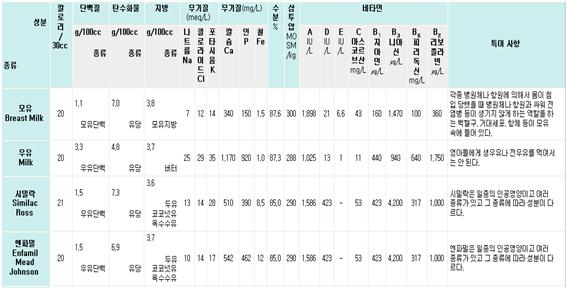
표 1-1(2).
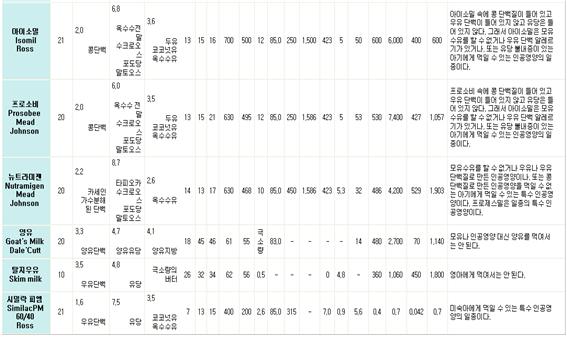
※ 인공영양의 성분과 성분의 용량이 다소 변경될 수 있다.
최근 거의 모든 인공영양에 DHA와 ARA의 성분이 포함되어 있다. 소스: 부모도 반의사가 되어야 한다―소아가정간호백과
The best gift for my newborn infant is the mom breast milk with the love 갓 태어난 내 아기에게 줄 수 있는 가장 좋은 선물은 사랑으로 주는 모유이다.

Photo 4-1. Breastfeeding and love
The best gift for my newborn infant is the mom breast milk with the love
Used with permission from Mead Johnson Nutritionals, USA
Breast milk is the pure love of mom and dad.
- Breast milk is the love of mom and dad.
- The complete nutrient I can feed my baby from birth is breast milk.
- It is also very important to feed my baby with the most nutritious breast milk, but the love of physical contact that occurs when the mother’s skin and the baby’s skin come into contact with each other during breastfeeding is also beyond description of how important it is to the baby and mother.
- In this way, love bonding between mother and child is firmly formed so that nothing can be cut off. Who in this world can break the love bond between mother and child?
- In addition, the nursing mother has the opportunity to drench her baby with eye-catching love while breastfeeding.
- In addition, it can also give you focused, interested love.
- Oxytocin is secreted from the posterior lobe of the pituitary gland of the brain.
- This hormone causes the uterus to contract during delivery. It promotes postpartum recovery after childbirth.
- It also acts to constrict the mammary glands and lactation ducts of the breast of the nursing mother to allow the breast milk to come out of the nipple cavity. It is a love hormone that gives the nursing mother a heart to embrace and love her baby. The oxytocin hormone is also called Love hormone, Love drugs, Cuddle chemicals, and Loving bonding hormone.
- This oxytocin is properly secreted by breastfeeding mothers. Raising my baby by breastfeeding is good for the mother’s breastfeeding baby, as well as the mental and physical health of the nursing mother and the baby’s father.
- It is also economical. Furthermore, it is infinitely good for improving the physical health of all the people of that country, and good for the mental health of all the people of that country.
- I am well aware that breastfeeding my beloved baby has many benefits for a baby’s mental and physical health.
- However, many mothers do not start breastfeeding because they do not know how to breastfeed. In addition, rather than raising a baby with artificial nutrition (Artificial formula/Infant formula, for reference, many people call artificial nutrition “powdered milk”), raising a baby by breastfeeding has many advantages not only for babies, but also for mothers and fathers. There are also mothers and fathers who do not know how to start breastfeeding at all.
- Many mothers and fathers think that the composition of breast milk and the composition of artificial nutrition are almost the same, or that they are the same.
- There are also many mothers and fathers who mistakenly believe that the ingredients of artificial nutrition are the best for the growth and development health of babies like those of breast milk.
- There are many mothers and fathers who think that when choosing between breastfeeding or artificial nutrition to raise a baby during pregnancy, you can just choose what you want to feed your baby.
- For one reason or another, there are many mothers and fathers who raise their babies with artificial nutrition instead of breastfeeding.
- (For reference, some mothers call “artificial nutrition” as “milk powder”). As it turns out, raising a baby with breastfeeding is much more convenient and easier than raising a baby with artificial nutrition, and babies raised with breastfeeding are much healthier than babies raised with artificial nutrition. Breast milk is a complete nutritional food for babies and a natural food full of nutritional value. In addition, breast milk is the love of mom and dad. Breast milk contains all the nutrients and energy that growing babies need. Breastfeeding is also excellent in preventing all diseases from occurring in a nursing baby.
- So, breast milk is a prophylactic, vaccine, and supplemental medicine that can prevent a baby’s disease.
- During breastfeeding, the baby is immersed in the eye contact love, physical contact love, intensive interest love and care received from the mother. Breastfed babies grow mentally and emotionally more satisfied and physically healthier.
- Even when I grow up, I live with more healthy self-esteem. When breastfeeding mothers and fathers also think that they can feed her mother’s milk directly to her baby and raise her precious children in a healthy way, her mother can be more proud, confident and satisfied in raising her children. So, love bonding is firmly formed between mother and baby.
- Unfortunately, various media outlets are stingy at emphasizing that raising babies through breastfeeding is good in many ways.
- In addition, women’s breasts are an organ in the human body for breastfeeding, but they are more related to the sexual or physical aspects. Many mothers and fathers are raising their babies with artificial nutrition instead of breastfeeding because of the wrong messages received here and there. It’s unfortunate.
- However, it is extremely fortunate that many mothers and fathers are increasingly aware that raising babies by breastfeeding has many benefits for babies, and the number of mothers and fathers who breastfeed is increasing.
- A few days ago, a global breastfeeding promotion event was held in Seoul hosted by the Korean Ministry of Health and Welfare, the Korean Society for Pediatrics and Adolescents, and the Korean Society of Obstetrics and Gynecology.
- I was very surprised to see about 300 women attending. I was surprised to see the government, the Department of Pediatrics and Obstetrics, who participated in breastfeeding.
- Glad it was.
- How about asking a baby born to a baby growing in the womb whether the mother or father will breastfeed her mother or otherwise take her artificial nutrition, and decide what to stay with? I want to give this option to the mother.
- Would you like to breastfeed your beloved baby or her mother’s breastfeeding.
U.S. breastfeeding status
- According to a US study, 32% of mothers after delivery do not even start breastfeeding.
- About 4% of mothers don’t breastfeed anymore, less than a week after they start breastfeeding.
- 13% of mothers breastfeed only for 1-4 weeks after delivery. And 51% say they breastfeed for at least 4 weeks after delivery.
- The US breastfeeding rate was 59% in 1995 and 74% in 2004. Up to 6 months of age, the US breastfeeding rate was 22% in 1995 and 42% in 2004.
- According to another study in the United States in 2004, the breastfeeding rate, mainly for breastfeeding, was 51% up to 7 days after delivery, and only 14% up to 6 months after delivery. (Source and reference; Arch Pediatr Adolesc Med. 2008.) The benefits of breastfeeding and breastfeeding
Advantages of breast milk and breastfeeding
- We have already explained the benefits of breastfeeding and breastfeeding.
- Let’s learn more specifically about the benefits of breastfeeding when raising a baby by breastfeeding.
- The temperature of the breast milk is suitable so that it can be fed directly to the baby anytime, anywhere.
- When raising a baby with artificial nutrition, the milk bottle, milk bottle cap, and milk bottle mug should be washed cleanly before feeding artificial nutrition.
- Sometimes the milk bottle, milk bottle teat, etc. must be sterilized with boiling water.
- The temperature of the artificial nutrients must be adjusted to make it easier to eat.
- When breastfeeding, there is no need to wash and disinfect milk bottles. Pathogens such as bacteria and viruses can be contaminated with artificial nutrition just before they are prepared for feeding
- During breastfeeding, bacteria, viruses, and other types of pathogens outside the nursing mother are not easily contaminated into the sucked breast milk. (See contraindications to breastfeeding)
- Babies who are breastfed and grow up are much less susceptible to infection by bacteria, viruses, and other pathogens than babies who are fed artificial nutrition.
- They are also less susceptible to infectious diseases, digestive problems, allergic gastroenteritis, and many other diseases.
- Childcare and medical expenses are saved, there are fewer days to go to the hospital, and there is less chance of receiving hospital inpatient treatment.
- Breastfed babies are less susceptible to viral gastroenteritis, respiratory problems, otitis media, diarrhea, bacterial meningitis, urinary tract infections, and other types of pathogen infections.
- Breast milk is better digested than artificial nutrition. Breast milk protects the baby by making it less susceptible to various diseases.
- Babies who feed on their mother’s milk are far less susceptible to allergic diseases such as allergic rhinitis, allergic digestive problems, bronchial asthma, and atopic dermatitis than babies who feed on artificial nutrition. Babies who are breastfed are less likely to suffer from infant colic and constipation than babies who are fed artificial nutrition.
- Allergic diseases can occur in babies who are nursing mother’s milk, but allergic diseases are much more common in babies who are fed on artificial nutrients containing milk protein or soy protein.
- Anti-pathogens such as IgA, leukocytes, giant cells, complements, lactoferrin, and Lysozyme, which can kill the pathogen when invaded by bacteria, viruses, and other types of pathogens, and Other biochemicals are contained in breast milk, but not in artificial nutrition.
- So nursing babies are less susceptible to various types of infectious diseases, including otitis media, gastroenteritis, sepsis, pneumonia, and urinary tract infections.
- In recent artificial nutrition, DHA and ARA ingredients, which are essential for enhancing brain and eye functions, are added and prepared, but natural DHA and ARA ingredients are sufficiently contained in breast milk.
- Other biochemical substances that can promote the growth and development of the body are also contained in breast milk.
- There are biochemical substances in breast milk that can prevent cancer. It contains hormones that promote growth and development.
- The IQ of children raised on artificial nutrition is lower than the IQ of children raised on breast milk and may be more prone to learning disabilities.
- No matter how well prenatal during pregnancy, children who grow up on artificial nutrition instead of breast milk have lower IQ.
- Children raised on artificial nutrition are more prone to overeating and become obese more easily.
- Childhood obesity occurs and eventually leads to adult obesity
The following is a one hundred question and answer on “Breastfeeding, Breast Structure, Breastfeeding Hormone Prolactin”.
Q.&A.
Breastfeeding, breast structure, the breastfeeding hormone prolactin
Q.
What is a breast?
A.
Mammary gland/breast, i.e., the breast is the outer branch that produces breast milk.
It is part of the female reproductive system.
The breast is located between the subcutaneous tissue of the anterior chest, between the 2nd to 6th ribs, between the great pectoral muscles, and between the sternum and axilla.
There is a nipple in the center of the breast. Nipples are called nipples. There is one nipple on each breast.
The part of the skin surrounding the root of the nipple is called the nipple ring, the areola, the nipple plate, and the nipple.
There is a Montgomery line on the areola. Here, sebum is secreted. (Refer to Figure 22-41)
Q. What is the internal structure of the breast?
A. There are 15-20 mammary gland lobes in one breast.
There are many mammary glands in each mammary gland.
The acinar gland is connected to the acinar gland gland.
The acinar gland secretory duct is connected to the bulge (flow).
The bulge (flow) is again connected to the duct (mammary duct).
The cannula is connected to the breast hole of the nipple.
Milk comes out of the breast hole in the nipple. (See picture breast)
Q. How does the breast produce milk?
A. When the baby sucks the nipple while breastfeeding and stimulates the areola→ Nerve impulse is transmitted to the hypothalamus of the brain→ A signal is sent from the hypothalamus to the posterior pituitary gland, where oxytocin (phytocin) is secreted→ Oxytocin surrounds the acinar gland. It stimulates muscle epithelial cells → milk (breast milk) is erupted from the acinar gland (mammary gland) → axillary gland secretion duct → bulge → milk duct (milk gland duct) → nipples → milk is secreted through the nipple breast hole. Connective and adipose tissue is located between each mammary gland lobe.
Q. How is the breast developed?
A. Until puberty, the structure of male and female breasts is almost the same. When puberty begins, female hormones called estrogen and progesterone are secreted by the luteal body of a woman’s ovary.
The mammary glands (milk glands) and acinar glands (milk secretion ducts) are developed and enlarged by the mons.
And fat tissue accumulates in the breast. So, the breasts of adolescent girls are beautifully enlarged.

Photo 4-2. Raising a baby through breastfeeding has so many benefits and benefits for the baby.
The physical contact love that occurs when the mother’s skin and the baby’s skin come into contact with each other during breastfeeding, as well as being able to receive the intensive care and care given by the mother is also beneficial for the baby and for the mother.
It’s just passing by without knowing that this is the case.
A nursing baby can receive eye contact love from her mother and her mother can also receive eye contact love from her baby.
This love only occurs with babies and nursing mothers who are breastfeeding while breastfeeding. Copyright ⓒ 2013 John Sangwon Lee, MD., FAAP

Photo 4-3. Look at the baby’s gaze!
The mother’s gaze and the baby’s gaze contact love! Through this kind of eye contact love, the bonding of love between mother and child is firmly formed.
This bonding of love is formed more firmly when breastfeeding. Copyright ⓒ 2011 John Sangwon Lee, MD., FAAP

Photo 4-4. Look at the baby’s gaze! The mother’s gaze and the baby’s gaze contact love! Through this kind of eye contact love, the bonding of love between mother and child is formed more firmly. Copyright ⓒ 2011 John Sangwon Lee, MD., FAAP

Photo 4-5. See the love of physical contact in a nursing baby!
The love of physical contact between the mother’s body and the baby!
Through this kind of physical contact love, the bond of love between mother and child is formed more firmly. Copyright ⓒ 2011 John Sangwon Lee, MD., FAAP

Photo 4-6. Look at the physical contact of a nursing baby!
The love of physical contact between the mother’s body and the baby!
Through this kind of physical contact love, Moagan’s love bonding is more firmly formed. Copyright ⓒ 2011 John Sangwon Lee, MD ., FAAP

Photo 4-7. There are many more things you need to feed on artificial nutrition. Copyright ⓒ 2011 John Sangwon Lee, MD., FAAP

Figure 4-1. After delivery, the uterus of a mother who is not breastfeeding is less affected by the phytosine hormone and gradually contracts and recovers slowly. Copyright ⓒ 2011 John Sangwon Lee, MD., FAAP

Figure 4-2. After delivery, the breastfeeding mother’s uterus contracts and recovers faster under the influence of the pitocine hormone. Copyright ⓒ 2011 John Sangwon Lee, MD., FAAP

Photo 4-8. There are several small nodules prominent in the papillary ring (areola, nipple plate). Those nodules are called Montgomery nodules. The Montgomery glands are located within the Montgomery tubercle. There, lubricating sebum like a cream is secreted. Copyright ⓒ 2011 John Sangwon Lee, MD., FAAP

Photo 4-9. Breast milk is at an appropriate temperature so that it can be eaten at any time without being warmed up. In the photo, the tip of the Montgomery projection on the areola is clearly visible. Copyright ⓒ 2011 John Sangwon Lee, MD., FAAP
Q.
You said that when you are pregnant, your breasts also change.
A.
When pregnant, many changes occur in the pregnant woman’s body. Among them, the more special and remarkable physical changes are those in the uterus and breasts.
Whether the future baby is born with breast milk or artificial nutrition, the pregnant woman develops acinar glands, lactation cells, and lactation glands in the breast so that my precious baby, who will be born in the future, can get enough milk and grow healthy.
In the breast, the mammary gland (the secretory relationship of the acinar gland), the bulge, and the milk duct (the mammary gland) are vigorously developed, the nipples are enlarged, the fat tissue in the breast is accumulated, and the entire breast is enlarged.
The Montgomery gland is developed in the areola, and sebum is produced there, making it more convenient for breastfeeding to proceed with all of the breasts. During the first time your breasts grow firmly, you may feel a little tingling and sore.
Especially if the nipples touch anywhere, it can be quite painful. There are 15 to 20 breast lobes in one breast. One breast lobe consists of several small breast lobules, The breast lobules are further subdivided again.
There are milk cells in the breast lobules that make milk.
Mammary cells gather to become mammary glands (acinar glands). This mammary gland is also called acinar gland, or mammary gland.
The tube through which the milk made from the mammary gland flows is called the acinar gland secretion tube. It is called the acinar gland secretion relationship throughout the large and small acinar gland glands. (See picture breast)
The sinus in the breast where the milk secreted from the mammary gland is confined before the baby sucks on the nipple is called a fluid or bulge. As soon as you become pregnant, the tissues of the lactation system inside the breast become larger and more developed.
And just before delivery, the function of the breast becomes more active without knowing it.
During pregnancy, by the action of the antiprolactin hormone secreted from the placenta, Prolactin stimulates the lactating cells of the acinar gland to prevent the secretion of milk.
After the baby is born, the placenta is in the uterus.
As soon as it is excreted, prolactin begins to stimulate the lactating cells and the lactating cells begin to make milk.
However, it takes 1 to 2 days for prolactin to start working vigorously after delivery.

Figure 4-3. Breast milk secretion, dilation of the cervix, breast milk secretion stimulating hormone (prolactin), oxytocin hormone that expels breast milk into the flow of the breast, prolactin hormone secretion that can occur when nipples are sucked, prolactin secretion inhibitory hormone. Copyright ⓒ 2011 John Sangwon Lee, MD ., FAAP
Q.
How does breast produce milk?
A.
When a baby sucks a nipple, peripheral nerves in the nipple and areola are stimulated.
At this time, a signal that the baby sucks is transmitted to the hypothalamus in the nursing mother’s brain through a neural impulse.
In the hypothalamus, nerve impulses are transmitted to the posterior lobe of the pituitary gland of the nursing mother.
Oxytocin/pitocin hormone is secreted from the posterior pituitary gland of a nursing mother, and the oxytocin hormone is It stimulates the muscle epithelial cells surrounding the acinar cells, causing the milk to be secreted into the acinar gland secretion duct.
It stimulates the acinar gland secretion relationship so that the breast milk that is already secreted into the flow in the breast lactation relationship from the milk cells in the breast flows out to the nipple through the acinar gland secretion relationship (oil duct).
At the same time, the nerve impulse generated by sucking the nipple is transmitted to the hypothalamus of the nursing mother and then to the anterior pituitary gland.
Prolactin hormone is secreted in the anterior lobe of the pituitary gland in nursing mothers. The prolactin hormone stimulates the lactation cells (milk cells) of the breast to promote lactation.
At the same time, blood circulation in the breast becomes more vigorous, the adipose tissue in the breast is more developed, and the fat accumulates in the breast.
Venous blood vessels in the subcutaneous tissue of the breast grow so large that they can be easily seen with the naked eye through the breast skin layer. Because the breast grows during pregnancy, a kidney plaque (glandular gland) can form in the skin layer of the breast.
When the baby sucks after delivery, nerve impulses are transmitted to the hypothalamus and then to the posterior pituitary.
Oxytocin is secreted from the posterior lobe of the pituitary gland, and breast milk is expelled. During pregnancy, prolactin cannot stimulate breasts until the baby is born due to prolactin secretion-suppressing hormones secreted from the placenta.
When we learn all these physiology, we think that the physiology of our body is made similar to the function of a computer chip.
Q.
Do I have to wash off the nipples and nipple rings when there is a creamy thing during pregnancy?
A.
During pregnancy, the nipple grows to a normal size, and there are 15-20 holes at the tip of the nipple that come out of the nipple.
The size of the areolas (nipple rings) around the roots of the nipples is also doubled. The color of the nipples and areolas changes to dark blackish brown or deep pink. Perhaps the color of the nipples and areolas has changed so that the breastfeeding baby can easily see and find them with the naked eye. There are normally several Montgomery nodules on the areola. In the Montgomery tubercle is the Montgomery gland, and cream-like lubricating sebum is secreted from it, which softens the areola and nipples so that the nipples and areolas do not split or burst during lactation. In other words, it is almost the same as oiling a machine to make it work. During pregnancy and during postpartum breastfeeding, lubricating sebum protects the nipples and areola. The creamy lubricious sebum from the Montgomery gland should not be washed off with soap. And there is no need to apply a special topical cream to the nipples or areolas.
Q.
The size of the breast is small, but will the baby get enough breast milk?
A.
There are many differences in breast size and shape depending on the pregnant woman. The breasts of all mothers, whether they are fairly large or small or sagged, are capable of secreting sufficient amounts of breast milk to allow one or both babies to eat and grow at the same time. The ultimate goal of the breast, which the pediatrician hopes for, is to give the baby a sense of stability and comfort, and to secrete enough warm breast milk so that the baby can eat and grow healthy. From around the 5th to 6th month of pregnancy, a few drops of clear milk may come out of several breast holes in the nipple. This is a kind of wet colostrum. This wet horse oil is also called.

Figure 4-4. Breast and nipple rings Copyright ⓒ 2011 John Sangwon Lee, MD ., FAAP

Figure 4-5. Breastfeeding and breast Copyright ⓒ 2011 John Sangwon Lee, MD., FAAP

Figure 4-6. The correlation between the baby’s mouth, breasts, and nipples when breastfeeding is also Copyright ⓒ 2011 John Sangwon Lee, MD., FAAP
Illustration of a non-pregnant adult woman’s breast, pregnant adult woman’s breast, breastfeeding adult woman’s breast

Figure 4-7. Comparison of breasts of non-pregnant women (a), breasts of pregnant women (b), and breasts of lactating women (c).
Women who are not pregnant have the smallest breasts.
This is because the acinar glands, acinar glands, flow, and mammary gland ducts (milk ducts) are much smaller than those in the breast of a nursing mother. The breasts of pregnant women are more developed and larger in the mammary glands.
The breast of a lactating woman is the largest and has a noticeable amount of fatty tissue.
The sagittal gland was also greatly developed.
The acinar gland duct is larger, the flow (bulge) is larger, and the mammary gland duct (milk duct) is also larger.
The nipples and areolas are also large. Source: Used with permission from Ross Laboratories, Columbus, Ohio 43216, Division of Laboratories, USA and Pediatric Family Nursing Encyclopedia.
Table Composition of mature breast milk, transitional breast milk, colostrum and cow’s milk 표 성숙 모유, 이행성(변이) 모유, 초유, 우유의 성분 비교표 k
| Breast milk,
colostrum milk
ingredient |
Breast milk | Cow’s milk | ||||||
| Mature Breast milk Secreted from the 15th to 15 months after delivery |
Transitional breast milk Secreted for 6 to 10 days after delivery |
Colostrum Secreted during the first 5 days after delivery
|
||||||
| Average | test range | Average | test range | Average | test range | Average | test range | |
| (kcal/liter) | ||||||||
| 747 | 446-1192 | 735 | 678-830 | 671 | 588-730 | 701 | 587-876 | |
| ml/liter | 3.127 | 1.867-4.989 | 3.076 | 2.838-3.474 | 2.808 | 2.461-3.055 | 2.934 | 2.457-3.666 |
| Specific gravity | 1.031 | 1.026-1.037 | 1.035 | 1.034-1.036 | 1.034 | – | 1.031 | 1.028-1.033 |
| Hydrogen ion concentration index | 7.01 | 6.4-7.6 | – | – | – | – | 6.6 | – |
| Solid quality, total (g/liter) | 129 | 103-175 | 133 | 105-156 | 128 | 100-167 | 124 | 119-142 |
| Ash, Total (g/liter) | 2.02 | 1.6-2.66 | 2.67 | 2.31-3.38 | 3.08 | 2.47-3.50 | 7.15 | 6.81-7.71 |
| Mineral (g/liter) | – | – | – | – | – | – | – | – |
| Positive electron element (㎎/liter) | 41 | – | 55 | – | 68 | – | 149 | 0.390-0.139 |
| Sodium (g/liter) | 0.172 | 0.064-0.436 | 0.294 | 0.192-0.539 | 0.501 | 0.265-1.37 | 0.768 | 0.392-0.139 |
| 0.189 | 0.080-0.350 | 0.536 | 0.170-1.21 | 0.956 | 0.330-2.24 | – | – | |
| Potassium (g/liter) | 0.512 | 0.373-0.635 | 0.636 | 0.528-0.769 | 0.745 | 0.658-0.870 | 1.43 | 0.38-2.87 |
| 0.553 | 0.425-0.735 | 0.692 | 0.450-0.910 | 0.581 | 0.220-0.790 | – | – | |
| Calcium (g/liter) | 0.344 | 0.173-0.609 | 0.464 | 0.23-0.628 | 0.481 | 0.242-0.656 | 1.37 | 0.56-3.81 |
| 0.271 | 0.207-0.372 | 0.320 | 0.166-0.420 | 0.261 | 0.180-0.364 | – | – | |
| Magnesium (g/liter) | 0.035 | 0.018-0.057 | 0.035 | 0.026-0.054 | 0.042 | 0.031-0.082 | 0.13 | 0.07-0.22 |
| Negative electron element (㎎/liter) | 28 | – | 37 | – | 40 | – | 108 | – |
| Phosphorus (g/liter) | 0.141 | 0.068-0.268 | 0.198 | 0.097-0.317 | 0.157 | 0.085-0.251 | 0.91 | 0.56-1.12 |
| Sulfur (g/liter) | 0.14 | 0.05-0.30 | 0.20 | 0.15-0.23 | 0.23 | 0.20-0.26 | 0.30 | 0.24-0.36 |
| Chlorine (g/liter) | 0.375 | 0.088-0.734 | 0.457 | 0.305-0.721 | 0.586 | 0.435-1.01 | 1.08 | 0.93-1.41 |
| Hyperpositive element (㎎/liter) | 13 | – | 18 | – | 28 | – | 41 | – |
| Very small substances | ||||||||
| Cobalt (㎎/liter) | 극소 | – | – | – | – | – | 0.6 | – |
| Iron (㎎/liter) | 0.50 | 0.20-0.80 | 0.59 | 0.29-1.45 | 1.0 | – | 0.45 | 0.25-0.75 |
| Zinc (㎎/liter) | 0.51 | – | 1.04 | – | 1.34 | – | 0.102 | – |
| Manganese (㎎/liter) | 극소 | – | 극소 | – | 극소 | – | 0.02 | 0.005-0.0067 |
| Zinc (㎎/liter) | 1.18 | 0.17-3.02 | 3.82 | 0.39-5.88 | 5.59 | 0.72-9.81 | 3.9 | 1.7-6.6 |
| Fluorine (㎎/liter) | 0.107 | 0.0-0.24 | – | – | 0.131 | 0.0-0.35 | – | 0.10-0.28 |
| IODINE (㎎/liter) | 0.061 | 0.044-0.093 | – | – | – | 0.045-0.450 | 0.116 | 0.036-1.05 |
| Selenium (㎎/liter) | 0.021 | – | – | – | – | – | 0.04 | 0.005-0.067 |
| Protein (g/liter) | ||||||||
| Tota | 10.6 | 7.3-20 | 15.9 | 12.7-18.9 | 22.9 | 14.6-68.0 | 32.46 | 28.16-36.76 |
Sources and references: Nelson textbook, 15 Edition p.121,
Pediatric nutrition handbook, American Academy of pediatric, p.354
OTHERS
| Breast milk,
colostrum milk
ingredient |
Breast milk | Cow’s milk | |||||||
| Mature Breast milk Secreted from the 15th to 15 months after delivery | Transitional breast milk Secreted for 6 to 10 days after delivery | Colostrum Secreted during the first 5 days after delivery | |||||||
| 성분 | Average | test range | Average | test range | Average | test range | Average | test range | |
| carbohydrate | |||||||||
| Lactose | |||||||||
| Direct estimate (g/liter) | 71 | 49-95 | 64 | 61-67 | 57 | 11-79 | 47 | 49-50 | |
| Difference | 68 | 50-92 | 64 | 60-68 | – | – | – | – | |
| Fructose (g/liter) | 1.3 | – | – | – | – | – | – | – | |
| Glucosamine (g/liter) | – | 0.7-0.8 | – | – | – | 1.4-4.3 | 0 | – | |
| Galactosamine (g/liter) | – | 0.0-0.4 | – | – | – | 0.04-0.7 | 0 | – | |
| Inositol (g/liter) | 0.45 | 0.39-0.56 |
– |
– | – | – | 0.08 | 0.06-0.12 | |
| Citric acid (g/liter) | – | 0.35-1.25 | – | – | – | – | 2.54 | 2.15-2.9 | |
| Fat, TOTAL (g/liter) | 45.4 | 13.4-82.9 | 35.2 | 27.3-51.8 | 29.5 | 24.7-31.8 | 38.0 | 34.0-61.0 | |
| Cholesterol (㎎/liter) | 139 | 88-202 | 241 | 126-320 | 280 | 180-345 | 110 | 70-170 | |
| Free cholesterol (총양의 %) | 76.1 | – | 76.5 | – | 79.5 | – | – | 90-95 | |
| Phosphorus lipid (㎎/liter) | 10.5 | 7-14 | 15.5 | 11-20 | 12 | 6-17 | – | 53-70 | |
| vitamin | |||||||||
| Vitamin A (㎎/liter) | 0.61 | 0.15-2.26 | 0.88 | 0.58-1.83 | 1.61 | 0.75-3.05 | 0.27 | 0.17-0.38 | |
| Catotine (㎎/liter) | 0.25 | 0.02-0.77 | 0.38 | 0.23-0.63 | 1.37 | 0.41-3.85 | 0.37 | 0.12-0.79 | |
| Vitamin D (IU/liter) | – | 4-100 | – | – | – | – | – | 5.40 | |
| Tocophero (㎎/liter) | 2.4 | 1.0-4.8 | 8.9 | 4.0-18.5 | 14.8 | 2.8-30.0 | 0.6 | 0.2-1.0 | |
| TtHIAMIN (㎎/liter) | 0.142 | 0.081-0.227 | 0.059 | 0.023-0.105 | 0.019 | 0.009-0.034 | 0.43 | 0.28-0.900 | |
| Riboflavin (㎎/liter) | 0.373 | 0.198-0.790 | 0.369 | 0.275-0.490 | 0.302 | 0.120-0.453 | 1.56 | 1.16-2.02 | |
| Vitamin B6 (㎎/liter) | 0.18 | 0.10-0.22 | – | – | – | – | 0.51 | 0.40-0.63 | |
| Nicotinic acid (㎎/liter) | 1.83 | 0.66-3.30 | 1.75 | 0.60-3.60 | 0.75 | 0.50-14.5 | 0.74 | 0.50-0.86 | |
| Vitami
n B₁₂ (㎍/liter) |
– | 극소량 | 0.36 | 0.03-0.70 | 0.45 | 0.10-1.5 | 6.6 | 3.2-12.4 | |
| Folic acid (IU/liter) | |||||||||
| (a) | 1.4 | 0.9-1.8 | 0.2 | 0.15-0.25 | 0.5 | 0.10-1.5 | 1.3 | 0.2-4.0 | |
| (b) | 24.0 | 7.4-61.0 | – | – | – | – | 37.7 | 16.8-63.2 | |
| (c) | 7.3 | 2.3-17.6 | – | – | – | – | 12.6 | 2.8-43.6 | |
| Biotin (IU/liter) | 2 | 1-3 | – | – | – | – | 22 | 14-29 | |
| Pentothe
nic acid |
2.46 | 0.86-5.84 | 2.88 | 1.35-4.12 | 1.83 | 0.29-3.02 | 3.4 | 2.2-5.5 | |
| Vitamin C | 52 | 0-112 | 71 | 45-90 | 72 | 47-104 | 11 | 3-23 | |
|
souce: From George DR, De Francesca BA.Human milk in comparison to cow milk.in: Lebenthal E, ed. Textbook of Gastroenterology and Nutrition in Infancy and Childhood. 2nd ed. New York, NY: Raven Press; 1989:242-243 |
| Breast milk,
colostrum milk
ingredient |
Breast milk | Cow’s milk | ||||||
| Mature Breast milk Secreted from the 15th to 15 months after delivery | Transitional breast milk Secreted for 6 to 10 days after delivery | Colostrum Secreted during the first 5 days after delivery | ||||||
| Average | test range | Average | test range | Average | test range | Average | test range | |
| Trimtopha | 3.7 | 1.4-6.8 | 5.1 | 4.2-5.9 | 21 | 7.3-52 | 24.9 | 21.9-28.0 |
| Whey protein | 7 | 4-10 | – | – | – | – | 7 | 6-10 |
| Milk albumin | 3.6 | 1.4-6.0 | 7.8 | 6.9-8.6 | – | – | 2.4 | 1.4-3.3 |
| Milk globulin | – | – | 5.0 | 2.1-13.6 | 35 | 4.2-133 | 1.7 | 0.7-3.7 |
| Serum albumin | 0.32 | 0.20-0.47 | 0.37 | 0.26-0.65 | 2.5 | – | 0.4 | – |
| Serum immunoglobum
in |
0.09 | 0.02-0.27 | 0.36 | 0.01-0.96 | 1.0 | – | 0.8 | – |
| Amino acid
(g/liter) |
||||||||
| Total | 12.8 | 9.0-16.0 | 9.4 | 6.0-10.0 | 12.0 | 7.0-40.0 | 33.0 | 27.0-41.0 |
| Alanine | – | 0.36-0.42 | – | – | – | – | 0.75 | – |
| -Arginine | 0.43 | 0.28-0.64 | 0.63 | 0.48-0.73 | 0.74 | 0.62-0.96 | 1.4 | 1.2-1.6 |
| Aspartic acid | – | 0.89-0.98 | – | – | – | – | 1.7 | – |
| Cystine | – | 0.23-0.25 | – | – | – | – | – | – |
| Glutamic acid | – | 1.89-2.00 | – | – | – | – | 6.8 | – |
| Glycine | – | 0.23-0.24 | – | – | – | – | 0.11 | – |
| Histidine | 0.24 | 0.12-0.30 | 0.38 | 0.29-0.45 | 0.41 | 0.35-0.46 | 1.2 | 1.1-1.3 |
| Isoleucine | 0.61 | 0.41-0.92 | 0.97 | 0.73-1.21 | 1.01 | 0.88-1.15 | 2.5 | 2.1-2.9 |
| Leucine | 0.97 | 0.65-1.47 | 1.51 | 1.13-1.97 | 1.66 | 1.33-2.14 | 3.6 | 3.2-3.9 |
| Lysine | 0.70 | 0.36-0.93 | 1.13 | 0.88-1.48 | 1.18 | 0.95-1.41 | 2.6 | 2.3-3.1 |
| Meth
isonine |
1.12 | 0.07-0.16 | 0.24 | 0.16-0.34 | 0.25 | 0.19-0.36 | 0.8 | 0.6-0.9 |
| Phenylalanine | 0.40 | 0.24-0.58 | 0.62 | 0.48-0.71 | 0.70 | 0.60-0.84 | 1.8 | 1.5-2.2 |
| Proline | – | 0.84-0.94 | – | – | – | – | 2.5 | – |
| Serine | – | 0.47-0.51 | – | – | – | – | 1.6 | – |
| Trionine | 0.52 | 0.30-0.66 | 0.78 | 0.61-0.91 | 0.85 | 0.75-1.04 | 1.7 | 1.3-2.2 |
| Trimtopha | 0.19 | 0.14-0.26 | 0.28 | 0.23-0.32 | 0.32 | 0.25-0.42 | 0.6 | 0.4-0.8 |
| Trionine | – | 0.46-0.52 | – | – | – | – | – | – |
| Valine | 0.73 | 0.45-1.14 | 1.05 | 0.77-1.36 | 1.17 | 0.98-1.49 | 2.6 | 2.4-2.8 |
| Non-protein urea (mg/liter) | ||||||||
| Total | 324 | 173-604 | 479 | 425-533 | 910 | 510-1270 | 252 | 181-323 |
| Urea-N | 180 | 127-235 | 111 | – | – | – | 132.7 | 61.3-204 |
| Uric acid-N | 22 | 13-41 | – | – | – | – | 24.1 | 11.3-36.9 |
| Creatinine-N | 11 | 8-19 | – | – | – | – | 7.05 | 1.9-12.2 |
| Creatine-N | 11 | 2-41 | – | – | – | – | 40.35 | 24.5-56.2 |
| Amino acid-N | 50 | 28-113 | 44 | – | – | 40-120 | 6.8 | 1.7-11.9 |
| Choline-N | 10.3 | 6.2-16.8 | – | – | – | – | 12 | 5-19 |
| The enzyme (mg/liter) | ||||||||
| Raizojam | 390 | 30-3000 | – | – | 460 | 90-1020 | 0.13 | 0.00-2.6 |
souce:: From George DR, De Francesca BA.Human milk in comparison to cow milk.in: Lebenthal E, ed. Textbook of Gastroenterology and Nutrition in Infancy and Childhood. 2nd ed. New York, NY: Raven Press; 1989:242-243
When invaded by various pathogens or antigens, breast milk contains leukocytes, giant cells, antibodies, etc. that fight the pathogens or antigens to prevent infectious diseases or allergic diseases.
Composition of breast milk, cow’s milk, goat’s milk, infant formula
표 모유, 우유, 양유, 인공영양의 성분 비교표

표 1-1(2).

※ The ingredients of artificial nutrition and the dosage of the ingredients may be slightly changed. The most recent artificial nutrition contains DHA and ARA ingredients. Source: www.drleepediatrics.com
출처 및 참조 문헌
- www.drleepediatrics.com 제1권 소아청소년 응급 의료
- www.drleepediatrics.com 제2권 소아청소년 예방
- www.drleepediatrics.com 제3권 소아청소년 성장 발육 육아
- www.drleepediatrics.com 제4권 모유,모유수유, 이유
- www.drleepediatrics.com 제5권 인공영양, 우유, 이유식, 비타민, 미네랄, 단백질, 탄수화물, 지방
- www.drleepediatrics.com 제6권 신생아 성장 발육 육아 질병
- www.drleepediatrics.com제7권 소아청소년 감염병
- www.drleepediatrics.com제8권 소아청소년 호흡기 질환
- www.drleepediatrics.com제9권 소아청소년 소화기 질환
- www.drleepediatrics.com제10권. 소아청소년 신장 비뇨 생식기 질환
- www.drleepediatrics.com제11권. 소아청소년 심장 혈관계 질환
- www.drleepediatrics.com제12권. 소아청소년 신경 정신 질환, 행동 수면 문제
- www.drleepediatrics.com제13권. 소아청소년 혈액, 림프, 종양 질환
- www.drleepediatrics.com제14권. 소아청소년 내분비, 유전, 염색체, 대사, 희귀병
- www.drleepediatrics.com제15권. 소아청소년 알레르기, 자가 면역질환
- www.drleepediatrics.com제16권. 소아청소년 정형외과 질환
- www.drleepediatrics.com제17권. 소아청소년 피부 질환
- www.drleepediatrics.com제18권. 소아청소년 이비인후(귀 코 인두 후두) 질환
- www.drleepediatrics.com제19권. 소아청소년 안과 (눈)질환
- www.drleepediatrics.com 제20권 소아청소년 이 (치아)질환
- www.drleepediatrics.com 제21권 소아청소년 가정 학교 간호
- www.drleepediatrics.com 제22권 아들 딸 이렇게 사랑해 키우세요
- www.drleepediatrics.com 제23권 사춘기 아이들의 성장 발육 질병
- www.drleepediatrics.com 제24권 소아청소년 성교육
- www.drleepediatrics.com 제25권 임신, 분만, 출산, 신생아 돌보기
- Red book 29th-31st edition 2021
- Nelson Text Book of Pediatrics 19th- 21st Edition
- The Johns Hopkins Hospital, The Harriet Lane Handbook, 22nd edition
- 응급환자관리 정담미디어
-
소아가정간호백과–부모도 반의사가 되어야 한다, 이상원
-
Neonatal Resuscitation American heart Association
-
Neonatology Jeffrey J.Pomerance, C. Joan Richardson
-
Pediatric Resuscitation Pediatric Clinics of North America, Stephen M. Schexnayder, M.D.
-
Pediatric Critical Care, Pediatric Clinics of North America, James P. Orlowski, M.D.
-
Preparation for Birth. Beverly Savage and Dianna Smith
-
Infectious disease of children, Saul Krugman, Samuel L Katz, Ann A. Gershon, Catherine Wilfert
- Pediatric Nutritional Handbook American Academy of Pediatrics
- 소아가정간호백과–부모도 반의사가 되어야 한다, 이상원
- The pregnancy Bible. By Joan stone, MD. Keith Eddleman, MD
- Neonatology Jeffrey J. Pomerance, C. Joan Richardson
- Preparation for Birth. Beverly Savage and Dianna Smith
- 임신에서 신생아 돌보기까지. 이상원
- Breastfeeding by Ruth Lawrence and Robert Lawrence
- Infectious disease of children, Saul Krugman, Samuel L Katz, Ann A. Gershon, Catherine Wilfert
- The Harriet Lane Handbook 19th Edition
- 제4권 모유, 모유수유, 이유 참조문헌 및 출처
- 제5권 인공영양, 우유, 이유, 비타민, 단백질, 지방 탄수 화물 참조문헌 및 출처
- 제6권 신생아 성장발육 양호 질병 참조문헌 및 출처
- 소아과학 대한교과서
- 그 외
|
Copyright ⓒ 2015 John Sangwon Lee, MD., FAAP 미국 소아과 전문의, 한국 소아청소년과 전문의 이상원 저 “부모도 반의사가 되어야 한다”-내용은 여러분들의 의사로부터 얻은 정보와 진료를 대신할 수 없습니다. “The information contained in this publication should not be used as a substitute for the medical care and advice of your doctor. There may be variations in treatment that your doctor may recommend based on individual facts and circumstances. “Parental education is the best medicine.” |